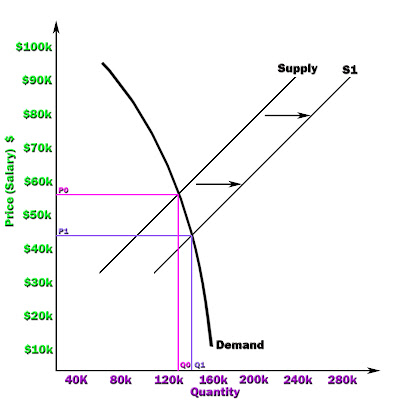Part 2 - Supply
Now that we can see what our future holds, what can we do to mitigate the damage that is about to occur? As we discussed below, there are two main issues, supply of Librarians and demand for Librarians. Both issues should be addressed. Today, we will examine Librarian supply.
Barriers to Entry (link)
This is an important business term for us to understand as it relates directly to the problem and solution to the Librarian supply dilemma. I suggest you spend a few minutes in wikipedia and brush up on the concept before continuing.
The first and easiest action we can take would be to control the supply of Librarians. As is stands now, there are only minimal barriers to entry to be a Librarian. What are the current Barriers to Entry?
1) HS Diploma
2) Bachelor Degree
3) Graduate Degree entrance exams
4) Masters in Library Science
5) Education Finance
At first glance, these five barriers may seem formidable, but lets examine them a bit closer to see the truth. We will look at the problems with each and examine some solutions.
HS Diploma – Not that difficult to get, almost everybody is able to pull this one off.
Bachelor Degree – There are many different types of Bachelor Degrees available. There are easy ones and hard ones, and all sorts of them in between. MLS programs take any degree. This is problematic for several reasons. First, you get tons of people that can barely pass college enrolling in the MLS program. Second, you get MLS graduates without the basic skills needed to run a library because they have some cheesy undergrad. Third, the mass of semi-smart librarians gives the librarian profession a bad reputation. “These are the least smart of all Masters Degreed people”, the marketplace mutters. Shh,, can you hear that whooshing sound? That is the sound of Demand dropping. Sorry, I am getting ahead of myself. That is the next blog.
What can be done? First, change the Undergraduate requirements to get into Library School. I suggest a business degree (any flavor, Economics, Finance, Accounting, all will do as the core curriculums are very similar) or a computer technology degree. Absolutely no more ‘easy’ degrees should be permitted. What practical good would a undergraduate in art, political science, history, anthropology, etc. be for a librarian?
None of these topics trains you in what is really important to run a library. Nor does it make you very marketable overall. Basically, you are lower quality then all the other graduates. Other professions have strict undergraduate requirements. To be a doctor you must have a life science undergraduate to get into medical school (with astounding grades). To get a Masters in criminal justice you have to have a C.J. undergrad. The list goes on. But to be a librarian? Any lame ass undergrad will do! Not good. I hear that sound again, do you?
You want a high dropout rate too btw. My undergrad (Information Systems) had around a 50% dropout rate! I kid you not. I made it ok, but half of my peers did not. Guess what? Right out of college I was worth $50k a year. Quality over quantity. The marketplace knows of this little theory. Librarians need to too. We need to wash out the inferior. Sounds cruel, but it is critical to the fix.
Graduate Degree entrance exams – Currently the passing scores on these entrance exams is a joke. Most high schoolers could pass the tests with ease. My scores on the GRE were way above minimal passing score, and I barely studied (brushed up on my calculus a bit). Entrance exams into other programs take weeks and months of study to pass, so too should the exams into the MLS program.
Masters in Library Science – Now we get to the meat. As is stands now, the curriculum is way too easy. Do not confuse easy with fast. The coursework takes a lot of time. But again, any highschooler could do it. My entire program I never took one real test! Not one! What? Ooo,, that is bad beyond words as far as program reputation is concerned. And, for the record, I passed with a perfect 4.0… without breaking a sweat. My undergrad was phenomenally more difficult then my MLS.
To make sure MLS graduates have the necessary skills to succeed there are two ways you can go. You can skip changing the undergraduate requirement and cover some of the basics during the MLS program, or you can rely on the undergraduate program to be sure people with an MLS know how to;
Manage People
Use a spreadsheet
Understand Accounting
Use a Database
Create a PowerPoint presentation
Skilled in public speaking
Know how to dress
Understand personnel basics
No person should graduate without these skills. Where they get them, not a big issue, but not having them after graduation? Big issue. Remember, we do not want the whooshing sound.
Education Finance – Last but not least we have a barrier to entry that is on par with the others. It costs about the same to get an Art History Degree as it does to get a Finance Degree. Same goes for the various Masters Degrees available. Here is one barrier that is in place properly. Thank goodness.
Next blog… Librarian Demand. This ones gonna sting. =P






